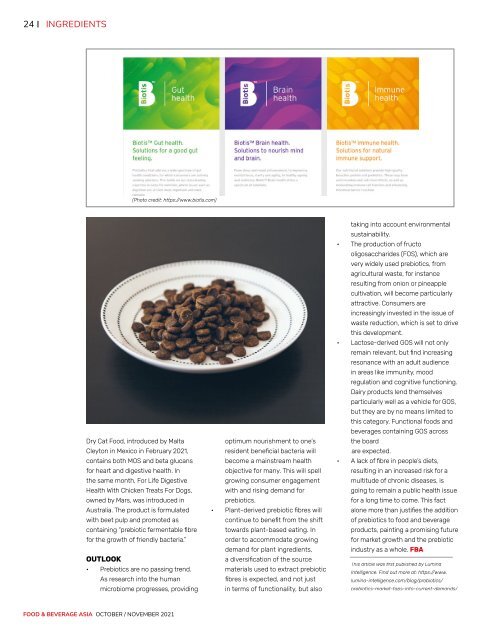Food & Beverage Asia October/November 2021
Food & Beverage Asia (FBA) is the leading source of food and beverage news in Asia since 2002. FBA delivers a comprehensive view of the food and beverage landscape, spanning across the latest health and nutrition trends and industry innovations in ingredients, recipe formulations, food science, sustainability, packaging, and automation, as well as advancements in agri and food-tech.
Food & Beverage Asia (FBA) is the leading source of food and beverage news in Asia since 2002. FBA delivers a comprehensive view of the food and beverage landscape, spanning across the latest health and nutrition trends and industry innovations in ingredients, recipe formulations, food science, sustainability, packaging, and automation, as well as advancements in agri and food-tech.
Create successful ePaper yourself
Turn your PDF publications into a flip-book with our unique Google optimized e-Paper software.
24<br />
INGREDIENTS<br />
(Photo credit: https://www.biotis.com)<br />
Dry Cat <strong>Food</strong>, introduced by Malta<br />
Cleyton in Mexico in February <strong>2021</strong>,<br />
contains both MOS and beta glucans<br />
for heart and digestive health. In<br />
the same month, For Life Digestive<br />
Health With Chicken Treats For Dogs,<br />
owned by Mars, was introduced in<br />
Australia. The product is formulated<br />
with beet pulp and promoted as<br />
containing “prebiotic fermentable fibre<br />
for the growth of friendly bacteria.”<br />
OUTLOOK<br />
• Prebiotics are no passing trend.<br />
As research into the human<br />
microbiome progresses, providing<br />
optimum nourishment to one’s<br />
resident beneficial bacteria will<br />
become a mainstream health<br />
objective for many. This will spell<br />
growing consumer engagement<br />
with and rising demand for<br />
prebiotics.<br />
• Plant-derived prebiotic fibres will<br />
continue to benefit from the shift<br />
towards plant-based eating. In<br />
order to accommodate growing<br />
demand for plant ingredients,<br />
a diversification of the source<br />
materials used to extract prebiotic<br />
fibres is expected, and not just<br />
in terms of functionality, but also<br />
taking into account environmental<br />
sustainability.<br />
• The production of fructo<br />
oligosaccharides (FOS), which are<br />
very widely used prebiotics, from<br />
agricultural waste, for instance<br />
resulting from onion or pineapple<br />
cultivation, will become particularly<br />
attractive. Consumers are<br />
increasingly invested in the issue of<br />
waste reduction, which is set to drive<br />
this development.<br />
• Lactose-derived GOS will not only<br />
remain relevant, but find increasing<br />
resonance with an adult audience<br />
in areas like immunity, mood<br />
regulation and cognitive functioning.<br />
Dairy products lend themselves<br />
particularly well as a vehicle for GOS,<br />
but they are by no means limited to<br />
this category. Functional foods and<br />
beverages containing GOS across<br />
the board<br />
are expected.<br />
• A lack of fibre in people’s diets,<br />
resulting in an increased risk for a<br />
multitude of chronic diseases, is<br />
going to remain a public health issue<br />
for a long time to come. This fact<br />
alone more than justifies the addition<br />
of prebiotics to food and beverage<br />
products, painting a promising future<br />
for market growth and the prebiotic<br />
industry as a whole. FBA<br />
This article was first published by Lumina<br />
Intelligence. Find out more at: https://www.<br />
lumina-intelligence.com/blog/probiotics/<br />
prebiotics-market-taps-into-current-demands/<br />
FOOD & BEVERAGE ASIA OCTOBER / NOVEMBER <strong>2021</strong>


















